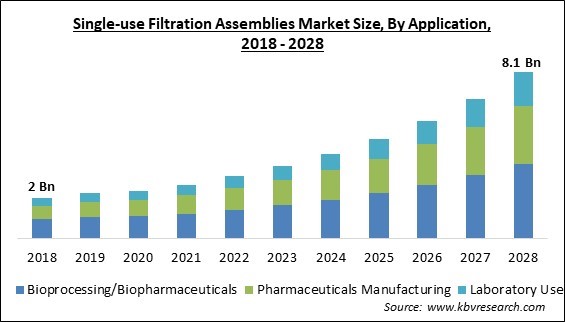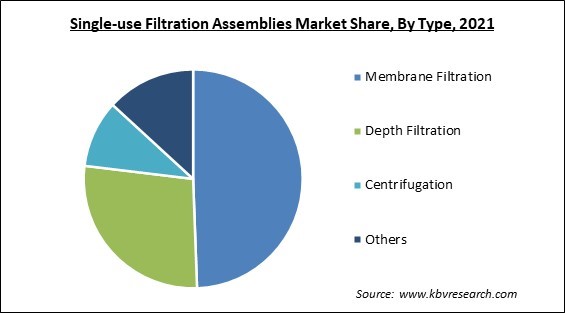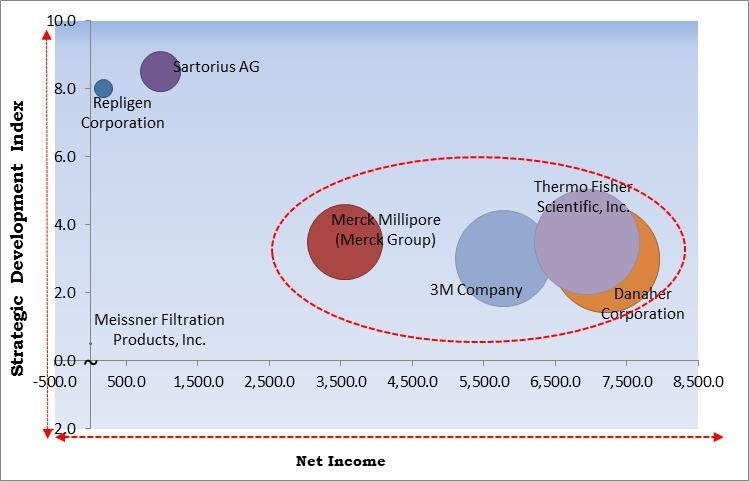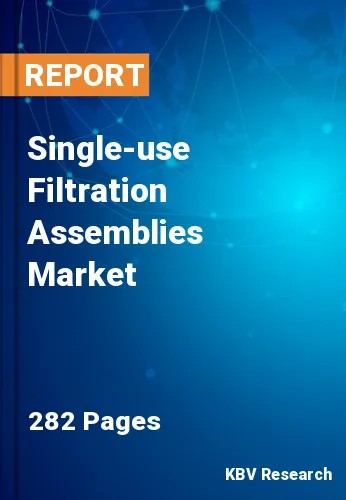The Global Single-use Filtration Assemblies Market size is expected to reach $8.1 billion by 2028, rising at a market growth of 17.8% CAGR during the forecast period.
Single-use components that guarantee a sterile fluid flow for pharmaceutical items are referred to as single-use assemblies. They are finished process systems with all-in-one, ready-to-use, customer-specific solutions made of different plastic pieces combined into one unit. Single-use assemblies provide the advantage of fewer concerns about cross-contamination and leakage, fewer production pauses, cheaper costs, and many other advantages.

In addition, the single-use filtration assemblies link the equipment and instruments used in laboratories and the medical field. Filtration assemblies, bottle assemblies, bag assemblies, and mixing system assemblies are the market's four primary categories of single-use assemblies. Filtration assemblies are utilized to vacuum filter various aqueous solutions, biological fluids, tissue culture medium, High-Performance Liquid Chromatography (HPLC), and other aqueous solutions.
Filtration assemblies include passing water through a porous medium to remove particle debris. Both generic and specialized solutions are available. Cell culture & mixing, storage, sampling, filtration, and fill-finish application are some of the several applications. Pharmaceutical and biopharmaceutical firms, academic and research institutions, and corporations performing contract research and production are some end users.
Since single-use filtration assemblies follow associated validation criteria and carry out sterilizing procedures, they eliminate the possibility of contamination compared to conventional stainless-steel systems. Each system is constructed according to welding application specifications using a reinforced hose.
The pandemic caused the suppliers to struggle to meet demand, which fueled the market expansion of single-use assembly. Because of the speed and flexibility needed, the platforms utilized to develop novel vaccines, like DNA, mRNA, and viral vectors, are typically built utilizing single-use technologies. Therefore, the pandemic may have affected market growth favorably because of the increasing demand for single-use assemblies. In addition, after the pandemic, the demand persisted due to the biopharmaceutical & pharmaceutical businesses that were the primary drivers of the market expansion's expansion using more single-use assemblies in developing and producing COVID-19 and other illnesses medicines. As a result, steady growth in the market is anticipated.
The biopharmaceutical industry has grown faster than the pharmaceutical sector in recent years. This industry will continue to expand, according to analysts. Recent and anticipated steady increases in biopharmaceutical sales are attributable, among other things, to the growth of the elderly population and the resulting rise in the prevalence of chronic conditions, the rising number of diabetes and cancer patients, and the rising incidence of autoimmune diseases. Understanding the mechanisms behind diverse medical disorders has aided the identification of particular variables and processes that cause pathological alterations. This has motivated the continuation of research into the applicability of biopharmaceuticals to new therapeutic contexts.
Healthcare businesses can utilize outsourcing as a way to reduce the rising expenses of providing services, which is becoming more increasingly pop. To provide high-quality healthcare facilities, healthcare organizations contract out a variety of services to multiple suppliers, including manufacturing or research. Medical record management, administrative costs, delivery costs, customer engagement, and clinical change are all reduced through healthcare outsourcing services for vendors. Furthermore, healthcare outsourcing lowers the cost of staff training and reduces billing errors. The market for single-use filtration assemblies is also predicted to grow as a result of the reduced cost.
The widespread demand to satisfy lower detection limits, which presents difficulties for equipment suppliers and laboratory scientists, is one of the main obstacles to leachables research. Modern mass spectrometry equipment and software are required to detect these low levels and analyze the data. Highly qualified and experienced analysts are required to design equipment methods or sample preparation techniques to satisfy these low analytical evaluation thresholds. In so-called dirty matrices like e-liquids, where natural flavors and biological samples can make it difficult to distinguish lower levels, prove to be important to formulation interference, the product formulation might affect sensitivity. Thus, the market expansion of single-use filtration assemblies is constrained by concerns about extractable and leachables.
Based on type, the single-use filtration assemblies market is segmented into membrane filtration, depth filtration, centrifugation and others. The depth filtration segment covered a considerable revenue share in the single-use filtration assemblies market in 2021. This is because of its outstanding efficiency, low protein binding, and great dirt-holding capacity. In addition, a wide variety of impurities and contaminants can be effectively removed due to the depth filtration media, which is typically composed of various layers of particles or fibers in various sizes.

On the basis of application, the single-use filtration assemblies market is divided into pharmaceuticals manufacturing market, bioprocessing/biopharmaceuticals market and laboratory use. In 2021, the bioprocessing/biopharmaceuticals market segment dominated the single-use filtration assemblies market with the maximum revenue share. Its expansion is attributable to the rising investment for research and development of biopharmaceutical goods. Single-use facilities are simpler to maintain in comparison to bioreactor systems.
By product, the single-use filtration assemblies market is classified into filters, cartridges, membranes, manifold, cassettes, syringes and others. The filter segment registered the maximum revenue share in the single-use filtration assemblies market in 2021. Filters for one-time use are among the most common and frequently used single-use technologies. Using flocculating chemicals, filter aids, and protective profilers can improve the effectiveness of depth filters during clarity processes. Merck Millipore and Sartorius employ these procedures. In addition, the automation of filtration methods is anticipated to contribute to the growth of this segment.
| Report Attribute | Details |
|---|---|
| Market size value in 2021 | USD 2.6 Billion |
| Market size forecast in 2028 | USD 8.1 Billion |
| Base Year | 2021 |
| Historical Period | 2018 to 2020 |
| Forecast Period | 2022 to 2028 |
| Revenue Growth Rate | CAGR of 17.8% from 2022 to 2028 |
| Number of Pages | 282 |
| Number of Table | 483 |
| Report coverage | Market Trends, Revenue Estimation and Forecast, Segmentation Analysis, Regional and Country Breakdown, Competitive Landscape, Companies Strategic Developments, Company Profiling |
| Segments covered | Application, Product, Type, Region |
| Country scope | US, Canada, Mexico, Germany, UK, France, Russia, Spain, Italy, China, Japan, India, South Korea, Singapore, Malaysia, Brazil, Argentina, UAE, Saudi Arabia, South Africa, Nigeria |
| Growth Drivers |
|
| Restraints |
|
Region-wise, the single-use filtration assemblies market is analyzed across North America, Europe, Asia Pacific, and LAMEA. The North America region led the single-use filtration assemblies market by generating the highest revenue share in 2021. The well-established public health system and rising demand for biopharmaceuticals in this region will further drive market expansion. In addition, several market leaders in North America have helped the market's expansion. Businesses are spending to fulfill the increased need for biotechnology solutions to enhance the manufacturing of vital components used to manufacture biologics, such as single-use technologies like bioreactor bags and syringe filters.
Free Valuable Insights: Global Single-use Filtration Assemblies Market size to reach USD 8.1 Billion by 2028

The major strategies followed by the market participants are Product Launches, Acquisitions and Expansions. Based on the Analysis presented in the Cardinal matrix; Merck Millipore (Merck Group), 3M Company, Danaher Corporation, Thermo Fisher Scientific, Inc. is the forerunners in the Single-use Filtration Assemblies Market. Companies such as Sartorius AG and Repligen Corporation are some of the key innovators in Single-use Filtration Assemblies Market.
The market research report covers the analysis of key stake holders of the market. Key companies profiled in the report include 3M Company, Sartorius AG, Repligen Corporation, Merck Millipore (Merck Group), Danaher Corporation, Thermo Fisher Scientific, Inc., Meissner Filtration Products, Inc., Cellab CDMO, Medela AG, and DrM, Dr. Mueller AG.
By Application
By Type
By Product
By Geography
The global Single-use Filtration Assemblies Market size is expected to reach $8.1 billion by 2028.
Emerging trend of medical outsourcing are driving the market in coming years, however, Problems associated with leachables and extractables restraints the growth of the market.
3M Company, Sartorius AG, Repligen Corporation, Merck Millipore (Merck Group), Danaher Corporation, Thermo Fisher Scientific, Inc., Meissner Filtration Products, Inc., Cellab CDMO, Medela AG, and DrM, Dr. Mueller AG.
The expected CAGR of the Single-use Filtration Assemblies Market is 17.8% from 2022 to 2028.
The Membrane Filtration segment acquired maximum revenue share in the Global Single-use Filtration Assemblies Market by Type in 2021 thereby, achieving a market value of $3.9 billion by 2028.
The North America market dominated the Global Single-use Filtration Assemblies Market by Region in 2021, and would continue to be a dominant market till 2028; thereby, achieving a market value of $3 billion by 2028.
Our team of dedicated experts can provide you with attractive expansion opportunities for your business.

